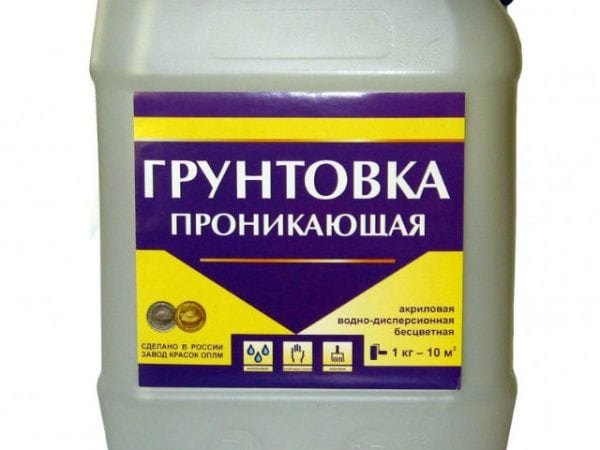Priming surfaces before painting or in the process of performing puttying is an obligatory step. Some primers have a fairly long shelf life, others are stored without harm to the quality of the product for less time. We will figure out what period of time after the indicated storage period these building materials can be used for priming the walls.
- Duration of storage of primers without loss of quality
- The main requirements of TU to soils
- In what cases can primers stored for more than 18 months be used?
- Masters Tips

Duration of storage of primers without loss of quality
With proper storage, the expiration date specified by the manufacturer for most primers designed for painting and puttying, without losing their basic qualities, is 18 months. Some manufacturers offer primers that have longer shelf life and are 24 months or longer from the date of manufacture.
Use of soil at the end of this period is possible only after checking their quality. In case of inconsistency of the primer mixtures with the basic TU standards, the manufacturer must replace them within six months from the date of shipment to the consumer.
to contents ↑The main requirements of TU to soils
Chemical building mixes intended for priming walls, like any other building materials, must meet certain technical conditions:
- The drying time of the created primer film should not exceed 24 hours at an ambient temperature of no higher than 4 degrees of heat, and at temperatures from +4 to + 25 ° C - no longer than 8 hours.
- After the hardener has been added to the primer, it must be suitable for use within 8 hours.
- Protective anticorrosive properties of primers must be maintained for three years.
- Priming building materials should be a homogeneous mass, without lumps and spots on the surface.
Primers that do not meet the specified requirements cannot be used for painting and puttying the walls, as they will not be able to provide the necessary quality and surface protection.
In what cases can primers stored for more than 18 months be used?
The shelf life indicated on the packaging by the soil manufacturer only indicates the period of time during which the product can be stored without losing the qualities guaranteed by the plant. Usually, after a specified period, the loss of chemical building materials quality below acceptable standards begins.
Naturally, a slight decrease will not affect the primed surface of the walls too much. In the event that the mixture has lost the necessary properties (drying speed, polymerization, protective functions), the primer cannot be used. Expired primers can be used if:
- During the entire storage period, the integrity of the container was not compromised and the product was not exposed to the environment.
- The primer during use did not overflow into another container.
- The material did not freeze during storage and was not exposed to overheating.
- If during the visual inspection of the primer mixture no abnormalities were found (the mass looks homogeneous, without lumps and film on the surface).
Typically, chemical building mixtures are stored for much longer than the expiration date specified by the manufacturer. The primer that has become unusable can be easily distinguished visually from the one that is still suitable for use.
At some point in time, the loss of the basic properties and qualities of these chemical building materials reaches its limit, after which the expired primer becomes completely unusable. Signs by which you can determine the change in the quality of the primer mixture:
- it exfoliated and a dense insoluble precipitate fell to the bottom of the container;
- film or spots formed on the surface;
- lumps and seals are present in it;
- a strong marsh odor appeared;
- she's too thick.
Masters Tips
Professionals recommend:
- If the expired primer mix intended for covering the walls is too thick, it can be diluted with a solvent (it is important that the solvent has the same base as the primer in its composition).
- To cover the walls, you can use soils with a slight loss of properties. For example, if the mixture began to dry two hours longer, but at the same time meets the rest of the technical requirements, there is no reason to refuse to use it.
- You can use only those primers that are designed directly to cover the material of which the surface of the walls consists. That is, for economic reasons, priming walls sheathed with metal profiled plates, expired soil, originally intended for the treatment of wooden surfaces, is unacceptable.
- If in the process of priming work you have to buy additional mixtures, you should take materials of the same grade that was used previously.
When deciding to buy new primers or, for the sake of economy, to use those that have been stored for a long time, one must carefully weigh the pros and cons. Given that chemical building materials are relatively inexpensive, perhaps you should not risk all repairs so as not to correct the result in the future.






